
|
Soldering iron |
|

|
Soldering Iron Wire Welding Lead Roll |
DIY Arduino Due TEA5767 FM Radio
This time I will show you how to make a small FM Radio with oled display which all functions are controlled by a single rotary encoder. So far I have made several FM radios, but this is my first project with an Arduino Due board.
The Arduino Due is a microcontroller board based on the Atmel ARM Cortex-M3 CPU. It is the first Arduino board based on a 32-bit ARM core microcontroller.
It has 54 digital input/output pins of which 12 can be used as PWM outputs, 12 analog inputs, 4 UARTs , a 84 MHz clock, an USB OTG capable connection, 2 (digital to analog), 2 TWI, a power jack, an SPI header, a reset button and an erase button.

The Due is compatible with all Arduino shields that work at 3.3V. The project is taken from https://www.changpuak.ch/ where it is named "Wacharamod" in honor of Khwankeo Vajarodaya, and where you can find the original schematic diagrams and code. In the hardware section I have omitted some resistors and filter capacitors for simplicity.

Otherwise, the device is relatively simple to build and contains the following components:
- TEA5767 small Radio board which is the basis of the whole project
- Arduino Due microcontroller board
- SH1106 Oled display
- LM4811 Headphone Amplifier with Digital Volume Control
- PAM8403 small audio D-class amplifier board
- Speaker
- and Rotary encoder
The radio module and other parts are mounted on a separate PCB compatible with Arduino Due pins, in my case it's experimental, but you can make a professional PCB, the cheapest, fastest, and highest quality at PCBWay. How to order is very easy and you will get 10 Pcs PCB for $5 with very great PCB quality TG150-160. Also You can design your own Gerber files for this circuit and upload it on their site (www.pcbway.com) Generally, shipping of the orders takes only 3 to 5 days.

Since this is my first project with Arduino Due, let me briefly explain how to upload a sketch to this board. First, we go to the Tools tab, then the board manager and in the search field we write Due. Now we need to install Arduino SAM Boards, which in my case are installed. Exit the board manager, and go to Tools > Board > Arduino Arduino ARM (32-bits) Boards. The Arduino Due has two USB ports available. We choose Programming port wich is the default for uploading sketches and communicating with the Arduino. After that we select the appropriate com port and we can upload the given sketch.

And now let's see how the radio works in real conditions. Immediately after switching on, the start screen appears on the screen with a logo and information about the software version. After that, the frequency of the radio station that was previously set in the code appears. In my case it is 94.8 megahertz where we can hear the local radio station. Short presses of the encoder change the focus under the frequency numbers, and rotating changes the value of the digit. After a few clicks, the focus moves to the volume bar, and now we can change the sound intensity by rotating it. With a long press on the rotary encoder, the radio switches to SEEK mode and starts automatic station search.

Finally, the device is installed in a suitable box made of PVC plastic with thicknesses of 3mm and 5mm and coated with a colored self-adhesive tape.
/* /////////////////////////////////////////////////////////////////////
ARDUINO/Genuino DUE Sketch for "Wachara 1"
https://www.changpuak.ch/electronics/Arduino-Shield-WACHARA1.php
As Wachara 1 passed away already, we use a white display
"Wachara 1" was the callsign of H.E. Khwankeo Vajarodaya,
*03.09.1928 †28.01.2017, my teacher for Siamese Culture and Art
Software Version 3.9,
03.09.2019, Alexander Sse Frank,
//////////////////////////////////////////////////////////////////////*/
// /////////////////////////////////////////////////////
// Includes
// /////////////////////////////////////////////////////
#include <Adafruit_GFX.h>
#include <Adafruit_SH1106.h>
// OLED 128x64 with SH1106 Controller
// from https://www.displaymodule.com/
// E.G. DM-OLED13-625
#define OLED_MOSI 10
#define OLED_CLK 9
#define OLED_DC 12
#define OLED_CS 13
#define OLED_RESET 11
Adafruit_SH1106 display(OLED_MOSI, OLED_CLK, OLED_DC, OLED_RESET, OLED_CS);
#if (SH1106_LCDHEIGHT != 64)
#error("Height incorrect, please fix Adafruit_SH1106.h!");
#endif
int CURSOR = 2 ;
float RX_FREQ = 107.6 ; // Radio Basilisk <3
// float freq = 102.50 ; // Surf 102.5 FM Hua Hin
float freq = 94.8 ; // KCS Radio Hua Hin
long int pll ;
int MAX_BAR_LENGTH = 45 ;
int MIN_BAR_LENGTH = 1 ;
float MULTI = 2.9 ;
// /////////////////////////////////////////////////////
// LM4811
// /////////////////////////////////////////////////////
int VolUpDownPin = A0 ;
int VolClkPin = A2 ;
int VolShutDownPin = A1 ;
int VOLUME = 0 ;
int SETVOL = 4 ;
int VOLMIN = 0 ;
int VOLMAX = 15 ; // 16 STEPS
// /////////////////////////////////////////////////////
// TEA 5767
// /////////////////////////////////////////////////////
const int BusMode = A5 ;
const int WriteRead = A4 ;
const int CursorX = 115 ;
const byte TEA5767_ADR = 0x60 ;
byte RAM[] = {0x00,0x00,0x00,0x00,0x00,0x00,0x00,0x00,0x00,0x00} ;
float BandStart = 87.5 ;
float BandStop = 108.0 ;
int RX_CLK_PIN = 21 ;
int RX_DAT_PIN = 20 ;
// /////////////////////////////////////////////////////
// WRITE
// /////////////////////////////////////////////////////
int HLSI = 1 ; // High Side Injection
int MUTE = 0 ; // L+R UNMUTED
int SM = 0 ; // NOT IN SEARCH MODE
int SUD = 1 ; // SEARCH UP
int SSL = 1 ; // SEARCH STOP LEVEL = LOW ADC output = 5
int MS = 0 ; // STEREO
int MR = 0 ; // RIGHT CHANNEL UNMUTED
int ML = 0 ; // LEFT CHANNEL UNMUTED
int BL = 0 ; // BAND LIMITS EUROPE
int XTAL = 1 ; // 32.768 kHz
int SMUTE = 1 ; // SOFT MUTE IS ON
int HCC = 0 ; // HIGH CUT CONTROL IS OFF
int SNC = 1 ; // STEREO NOISE CANCELLING IS ON
int DTC = 0 ; // de-emphasis time constant is 50 µs
// /////////////////////////////////////////////////////
// READ
// /////////////////////////////////////////////////////
int RF = 0 ;
int BLF = 0 ;
int Stereo = 0 ;
int RSSI = 0 ;
int IFCounts = 0 ;
volatile boolean SearchMode = false ;
// ////////////////////////////////////////////////////////////////////
// ROTARY ENCODER
// ////////////////////////////////////////////////////////////////////
const int KEY1 = 6 ;
const int KEY2 = 7 ;
const int KEY3 = 5 ; // PRESSED
volatile boolean action = false ;
volatile boolean pressed = false ;
volatile boolean clockwise = false ;
volatile boolean rotation = false ;
unsigned int ShortLongPressTime = 600 ; // MILLISECONDS
// IF THE KNOB WAS PRESSED SHORTER, IT IS CONSIDERED "SHORT"
// IF THE KNOB WAS PRESSED LONGER, IT IS CONSIDERED "LONG"
boolean LongPress = false ;
void ISR_K1 (void)
{
byte autre = digitalRead(KEY2) ;
if (autre == 1) clockwise = true ;
else clockwise = false ;
action = true ;
pressed = false ;
rotation = true ;
}
void ISR_K2 (void)
{
byte autre = digitalRead(KEY1) ;
if (autre == 1) clockwise = true ;
else clockwise = false ;
action = true ;
pressed = false ;
rotation = true ;
}
void ISR_K3 (void)
{
pressed = true ;
action = true ;
rotation = false ;
}
// ////////////////////////////////////////////////////////////////////
byte HIBYTE(unsigned int data)
{
return ((data & 0xFF00) >> 8) ;
}
// ////////////////////////////////////////////////////////////////////
byte LOBYTE(unsigned int data)
{
return (data & 0x00FF) ;
}
// ////////////////////////////////////////////////////////////////////
void VolumeUp(int HowMuch)
{
digitalWrite(VolUpDownPin, HIGH);
for(int i=0; i < HowMuch; i++)
{
VOLUME += 1 ;
digitalWrite(VolClkPin, HIGH);
delay(100) ;
digitalWrite(VolClkPin, LOW);
delay(100) ;
UpdateOLED() ;
}
}
// ////////////////////////////////////////////////////////////////////
void VolumeDown(int HowMuch)
{
digitalWrite(VolUpDownPin, LOW);
for(int i=0; i < HowMuch; i++)
{
digitalWrite(VolClkPin, HIGH);
digitalWrite(VolClkPin, LOW);
}
VOLUME = 0 ;
UpdateOLED() ;
}
// ////////////////////////////////////////////////////////////////////
void SET_VOLUME()
{
digitalWrite(VolUpDownPin, LOW);
for(int i=0; i < 18; i++)
{
digitalWrite(VolClkPin, HIGH);
digitalWrite(VolClkPin, LOW);
}
digitalWrite(VolUpDownPin, HIGH);
for(int i=0; i < VOLUME; i++)
{
digitalWrite(VolClkPin, HIGH);
digitalWrite(VolClkPin, LOW);
}
UpdateOLED() ;
}
// ////////////////////////////////////////////////////////////////////
void VolumeMute()
{
digitalWrite(VolShutDownPin, HIGH);
}
// ////////////////////////////////////////////////////////////////////
void VolumeUnMute()
{
digitalWrite(VolShutDownPin, LOW);
}
// ////////////////////////////////////////////////////////////////////
void setup()
{
// TEA5767
pinMode(BusMode, OUTPUT);
digitalWrite(BusMode, HIGH);
pinMode(RX_DAT_PIN, OUTPUT);
digitalWrite(RX_DAT_PIN, LOW);
pinMode(RX_CLK_PIN, OUTPUT);
digitalWrite(RX_CLK_PIN, LOW);
pinMode(WriteRead, OUTPUT);
digitalWrite(WriteRead, HIGH);
// LMX4811
pinMode(VolUpDownPin, OUTPUT);
digitalWrite(VolUpDownPin, LOW); // JUST TO HAVE A DEFINED LEVEL
pinMode(VolClkPin, OUTPUT);
digitalWrite(VolClkPin, LOW);
pinMode(VolShutDownPin, OUTPUT);
digitalWrite(VolShutDownPin, LOW); // SWITCH THAT THING ON
// This shutdown function is activated by applying a logic high
// to the SHUTDOWN pin.
Serial.begin(9600); // SERIAL
// INIT OLED
display.begin(SH1106_SWITCHCAPVCC);
// SHOW STARTUP SCREEN
display.clearDisplay();
display.drawLine(0, 14, 128, 14, WHITE);
display.setTextSize(1);
display.setTextColor(WHITE);
display.setCursor(0,0); display.print("*****") ;
display.setCursor(33,0); display.print(" MIRCEMK") ;
display.setCursor(90,0); display.print("******") ;
display.setTextSize(1);
display.setCursor(0,21);
display.println("A MULTIBAND RECEIVER");
display.setCursor(0,33);
display.println("WITH NXP's TEA5767");
display.setCursor(0,45);
display.println("IN MEMORIAM WACHARA 1");
display.setCursor(0,57);
display.println("BUILT 03.09.2019");
display.display();
delay(4999) ;
VolumeDown(18) ; // YES, WE USE THE COMMODORE 1541 APPROACH HERE
// FREQ_TEA5767(freq) ;
HiLoOptimiser() ;
delay(100) ;
// FREQ_TEA5767(freq) ;
HiLoOptimiser() ;
Serial.println("TEA5767 RADIO, TYPE WACHARA 1");
Serial.println("-----------------------------");
READ_TEA5767() ;
Serial.println(RAM[0],HEX) ;
Serial.println(RAM[1],HEX) ;
Serial.println(RAM[2],HEX) ;
Serial.println(RAM[3],HEX) ;
Serial.println(RAM[4],HEX) ;
Serial.println("-----------------------------");
VOLUME = SETVOL ;
SET_VOLUME() ;
UpdateOLED() ;
// ROTARY ENCODER
pinMode(KEY1, INPUT_PULLUP) ;
pinMode(KEY2, INPUT_PULLUP) ;
pinMode(KEY3, INPUT_PULLUP) ;
// INTERRUPTS ROTARY ENCODER
attachInterrupt(digitalPinToInterrupt(KEY1), ISR_K1, RISING); // ROT
attachInterrupt(digitalPinToInterrupt(KEY2), ISR_K2, FALLING); // ROT
attachInterrupt(digitalPinToInterrupt(KEY3), ISR_K3, FALLING); // PRESS
delay(3999);
action = false ;
pressed = false ;
clockwise = false ;
rotation = false ;
// SCAN() ;
freq = 94.80 ;
HiLoOptimiser() ;
}
// ////////////////////////////////////////////////////////////////////
void BAR(int x, int y, int value)
{
if (value > MAX_BAR_LENGTH) value = MAX_BAR_LENGTH ;
if (value < MIN_BAR_LENGTH) value = MIN_BAR_LENGTH ;
display.drawRect(x, y, MAX_BAR_LENGTH, 7, WHITE);
display.fillRect(x, y, value, 7, WHITE);
}
// ////////////////////////////////////////////////////////////////////
void UpdateOLED()
{
display.clearDisplay();
display.drawLine(0, 11, 128, 11, WHITE);
display.drawLine(0, 32, 128, 32, WHITE);
display.setTextSize(1);
display.setTextColor(WHITE);
display.setCursor(0,0); display.print("*****") ;
display.setCursor(33,0); display.print(" MIRCEMK") ;
display.setCursor(90,0); display.print("******") ;
display.setTextSize(2);
display.setCursor(0,15);
if(!SearchMode)
{
if (freq < 100.0) display.print(" ");
if (freq < 10.0) display.print(" ");
display.print(freq,3);
// display.print("0");
// CURSOR
if (CURSOR == 0) { display.setCursor( 0,19); display.print("_") ; }
if (CURSOR == 1) { display.setCursor(12,19); display.print("_") ; }
if (CURSOR == 2) { display.setCursor(24,19); display.print("_") ; }
if (CURSOR == 3) { display.setCursor(48,19); display.print("_") ; }
if (CURSOR == 4) { display.setCursor(60,19); display.print("_") ; }
display.setCursor(92,15);
display.print("MHz");
}
if(SearchMode)
{
display.setCursor(10,15);
display.print("SEARCHING");
}
display.setTextSize(1);
display.setCursor(0,37);
display.print("RSSI ");
if(HLSI == 1) display.print("+");
if(HLSI == 0) display.print("-");
BAR(40, 37, (RSSI*3) ) ;
display.setCursor(91,37);
if (Stereo == 1) display.print("STEREO");
if (Stereo == 0) display.print(" MONO");
display.setCursor(0,47);
display.print("VOLUME "); BAR(40, 47, (VOLUME*3) ) ;
if (CURSOR == 5) { display.setCursor(91,47); display.print("<<<") ; }
display.setCursor(0,57);
display.print("PRESS LONG TO SEARCH");
display.display();
}
void ButtonPressed()
{
// //////////////////////////////////////////////////
// WAS IT PRESSED LONG >>> START SEARCH UP
// //////////////////////////////////////////////////
LongPress = false ;
delay(ShortLongPressTime) ;
if(digitalRead(KEY3) == 0) LongPress = true ;
if(LongPress)
{
// //////////////////////////////////////////////////
// SEARCH UPWARDS
// //////////////////////////////////////////////////
Serial.println("PRESSED LONG") ;
SearchUP() ;
pressed = false ;
}
// //////////////////////////////////////////////////
// WAS IT PRESSED SHORT >>> MOVE CURSOR RIGHT
// //////////////////////////////////////////////////
if(!LongPress)
{
Serial.println("PRESSED SHORT") ;
CURSOR += 1 ;
if(CURSOR > 5) CURSOR = 2 ;
}
pressed = false ;
}
void ButtonRotated()
{
// //////////////////////////////////////////////////
// WAS IT ROTATED RIGHT >>> INCREASE
// //////////////////////////////////////////////////
if(clockwise)
{
// Serial.println("CW") ;
switch(CURSOR)
{
case 2:
freq = freq - 1.0 ;
if(freq < BandStart) freq = BandStart ;
HiLoOptimiser() ;
delay(10) ;
READ_TEA5767() ; // RSSI
break ;
case 3:
freq = freq - 0.1 ;
if(freq < BandStart) freq = BandStart ;
HiLoOptimiser() ;
delay(10) ;
READ_TEA5767() ; // RSSI
break ;
case 4:
freq = freq - 0.01 ;
if(freq < BandStart) freq = BandStart ;
HiLoOptimiser() ;
delay(10) ;
READ_TEA5767() ; // RSSI
break ;
case 5:
VOLUME = VOLUME - 1 ;
if(VOLUME < VOLMIN ) VOLUME = VOLMIN ;
SET_VOLUME() ;
break ;
}
rotation = false ;
UpdateOLED() ;
}
// //////////////////////////////////////////////////
// WAS IT ROTATED LEFT >>> DECREASE
// //////////////////////////////////////////////////
if(!clockwise)
{
// Serial.println("CCW") ;
switch(CURSOR)
{
case 2:
freq = freq + 1.0 ;
if(freq > BandStop) freq = BandStop ;
HiLoOptimiser() ;
delay(10) ;
READ_TEA5767() ; // RSSI
break ;
case 3:
freq = freq + 0.1 ;
if(freq > BandStop) freq = BandStop ;
HiLoOptimiser() ;
delay(10) ;
READ_TEA5767() ; // RSSI
break ;
case 4:
freq = freq + 0.01 ;
if(freq > BandStop) freq = BandStop ;
HiLoOptimiser() ;
delay(10) ;
READ_TEA5767() ; // RSSI
break ;
case 5:
VOLUME = VOLUME + 1 ;
if(VOLUME > VOLMAX ) VOLUME = VOLMAX ;
SET_VOLUME() ;
break ;
}
rotation = false ;
UpdateOLED() ;
}
}
void READ_TEA5767()
{
pinMode(RX_DAT_PIN, INPUT);
digitalWrite(RX_CLK_PIN, HIGH);
delay(1) ;
digitalWrite(WriteRead, HIGH);
delay(1) ;
digitalWrite(WriteRead, LOW);
delay(1) ;
RAM[0] = shiftIn(RX_DAT_PIN, RX_CLK_PIN, MSBFIRST) ;
RAM[1] = shiftIn(RX_DAT_PIN, RX_CLK_PIN, MSBFIRST) ;
RAM[2] = shiftIn(RX_DAT_PIN, RX_CLK_PIN, MSBFIRST) ;
RAM[3] = shiftIn(RX_DAT_PIN, RX_CLK_PIN, MSBFIRST) ;
RAM[4] = shiftIn(RX_DAT_PIN, RX_CLK_PIN, MSBFIRST) ;
Stereo = (RAM[2] & 0x80) >> 7 ;
RSSI = (RAM[3] & 0xF0) >> 4 ;
RF = (RAM[0] & 0x80) >> 7 ;
BLF = (RAM[0] & 0x40) >> 6 ;
IFCounts = RAM[2] & 0x7F ;
}
void WRITE_TEA5767()
{
pinMode(RX_DAT_PIN, OUTPUT);
digitalWrite(RX_CLK_PIN, LOW); delay(1) ;
digitalWrite(WriteRead, LOW); delay(1) ;
digitalWrite(WriteRead, HIGH); delay(1) ;
if(HLSI == 1) pll=(int)(((freq+0.225)*122.0703125)+0.5);
if(HLSI == 0) pll=(int)(((freq-0.225)*122.0703125)+0.5);
RAM[5] = HIBYTE(pll) | (MUTE<<7) | (SM<<6) ;
RAM[6] = LOBYTE(pll) ;
RAM[7] = (SUD<<7)|(SSL<<5)|(HLSI<<4)|(MS<<3)|(MR<<2)|(ML<<1) ;
RAM[8] = (BL<<5)|(XTAL<<4)|(SMUTE<<3)|(HCC<<2)|(SNC<<1);
RAM[9] = DTC<<6 ;
shiftOut(RX_DAT_PIN, RX_CLK_PIN, MSBFIRST, RAM[5]);
shiftOut(RX_DAT_PIN, RX_CLK_PIN, MSBFIRST, RAM[6]);
shiftOut(RX_DAT_PIN, RX_CLK_PIN, MSBFIRST, RAM[7]);
shiftOut(RX_DAT_PIN, RX_CLK_PIN, MSBFIRST, RAM[8]);
shiftOut(RX_DAT_PIN, RX_CLK_PIN, MSBFIRST, RAM[9]);
}
void HiLoOptimiser()
{
int RSSIHigh = 0 ;
int RSSILow = 0 ;
float Frequency = freq ;
SM = 0 ; // NOT IN SEARCH MODE
VolumeMute() ;
if (Frequency > BandStop) Frequency = BandStop ;
if (Frequency < BandStart) Frequency = BandStart ;
// //////////////////////////////////////////////////
// RSSIHigh is at freq + 450 kHz
// //////////////////////////////////////////////////
freq = Frequency + 0.225 ;
HLSI = 1 ;
WRITE_TEA5767() ;
delay(10) ;
READ_TEA5767() ;
RSSIHigh = RSSI ;
// //////////////////////////////////////////////////
// RSSILow is at freq - 450 kHz
// //////////////////////////////////////////////////
HLSI = 0 ;
freq = Frequency - 0.225 ;
WRITE_TEA5767() ;
delay(10) ;
READ_TEA5767() ;
RSSILow = RSSI ;
// //////////////////////////////////////////////////
// EVALUATION SEE APPLICATION NOTE PAGE 27
// //////////////////////////////////////////////////
if(RSSIHigh < RSSILow)
{
// OPTIMUM SETTING IS HIGH SIDE INJECTION
HLSI = 1 ;
freq = Frequency ;
WRITE_TEA5767() ;
}
else
{
// OPTIMUM SETTING IS LOW SIDE INJECTION
HLSI = 0 ;
freq = Frequency ;
WRITE_TEA5767() ;
}
delay(27);
READ_TEA5767() ;
VolumeUnMute() ;
UpdateOLED() ;
}
void SCAN()
{
freq = BandStart ;
while(freq <= BandStop)
{
HiLoOptimiser() ;
if(RSSI >=4)
{
if(freq <100.0) Serial.print(" ");
Serial.print(freq,3); Serial.print(" RSSI: ");
Serial.print(RSSI,DEC);
Serial.print(" IFC: ");
Serial.println(IFCounts,DEC);
}
freq += 0.098304 ;
delay(30);
}
}
void SearchUP()
{
Serial.println("SEARCHING ...");
SearchMode = true ;
UpdateOLED() ;
int RSSILAST = 0 ;
int RSSICURR = 0 ;
int RSSINEXT = 0 ;
boolean STOPSEARCH = false ;
float Frequency = freq ;
while(!STOPSEARCH)
{
freq += 0.098304 ;
HiLoOptimiser() ;
if(RSSI >=4)
{
if(freq <100.0) Serial.print(" ");
Serial.print(freq,3);
Serial.print(" RSSI: ");
if(RSSI < 10) Serial.print(" ");
Serial.print(RSSI,DEC);
Serial.print(" IFC: ");
Serial.println(IFCounts,DEC);
if((IFCounts > 56) && (IFCounts < 71))
{
STOPSEARCH = true ;
SearchMode = false ;
Serial.println("FOUND.");
}
} // END RSSI-IF
if(freq >= BandStop)
{
freq = BandStart ;
STOPSEARCH = true ;
SearchMode = false ;
} // END BANDSTOP
delay(100);
} // END WHILE
SearchMode = false ;
UpdateOLED() ;
}
// /////////////////////////////////////////////////////////////
// UNUSED FUNCTIONS
// /////////////////////////////////////////////////////////////
void FREQ_TEA5767(float FRQ)
{
int aux ;
if (FRQ > BandStop) FRQ = BandStop ;
if (FRQ < BandStart) FRQ = BandStart ;
pll = (int)((( FRQ + 0.225 ) * 122.0703125 ) + 0.5 );
RAM[5] = HIBYTE(pll) ;
RAM[6] = LOBYTE(pll) ;
// Search Up, Low Volume, High Side Injection, Stereo, No Mute
RAM[7] = 0xC0;
// EU Band, Clock 32768, Stero Noise Cancelling On
RAM[8] = 0x12 ;
RAM[9] = 0x00 ; // De-Emphasis Time Constant is 50 µs
pinMode(RX_DAT_PIN, OUTPUT);
delay(1) ;
digitalWrite(WriteRead, LOW);
delay(1) ;
digitalWrite(WriteRead, HIGH);
delay(1) ;
shiftOut(RX_DAT_PIN, RX_CLK_PIN, MSBFIRST, RAM[5]);
shiftOut(RX_DAT_PIN, RX_CLK_PIN, MSBFIRST, RAM[6]);
shiftOut(RX_DAT_PIN, RX_CLK_PIN, MSBFIRST, RAM[7]);
shiftOut(RX_DAT_PIN, RX_CLK_PIN, MSBFIRST, RAM[8]);
shiftOut(RX_DAT_PIN, RX_CLK_PIN, MSBFIRST, RAM[9]);
}
// /////////////////////////////////////////////////////////////
void loop()
{
if (action)
{
if(pressed) ButtonPressed() ;
if(rotation) ButtonRotated() ;
action = false ;
UpdateOLED() ;
}
delay(9) ;
}
// /////////////////////////////////////////////////////////////
// END OF FILE
// /////////////////////////////////////////////////////////////


DIY Arduino Due TEA5767 FM Radio
*PCBWay community is a sharing platform. We are not responsible for any design issues and parameter issues (board thickness, surface finish, etc.) you choose.
- Comments(0)
- Likes(0)
- 0 USER VOTES
- YOUR VOTE 0.00 0.00
- 1
- 2
- 3
- 4
- 5
- 6
- 7
- 8
- 9
- 10
- 1
- 2
- 3
- 4
- 5
- 6
- 7
- 8
- 9
- 10
- 1
- 2
- 3
- 4
- 5
- 6
- 7
- 8
- 9
- 10
- 1
- 2
- 3
- 4
- 5
- 6
- 7
- 8
- 9
- 10
 More by Mirko Pavleski
More by Mirko Pavleski
-
 Arduino 3D Printed self Balancing Cube
Self-balancing devices are electronic devices that use sensors and motors to keep themselves balanc...
Arduino 3D Printed self Balancing Cube
Self-balancing devices are electronic devices that use sensors and motors to keep themselves balanc...
-
 How to make simple Variable HIGH VOLTAGE Power Supply
High Voltage Power Supply is usually understood as a device that is capable of generating a voltage...
How to make simple Variable HIGH VOLTAGE Power Supply
High Voltage Power Supply is usually understood as a device that is capable of generating a voltage...
-
 DIY 5-Day Rainfall Forecast Device - ESP32 E-Paper Project
In several of my previous projects I have presented ways to make weather stations, but this time I ...
DIY 5-Day Rainfall Forecast Device - ESP32 E-Paper Project
In several of my previous projects I have presented ways to make weather stations, but this time I ...
-
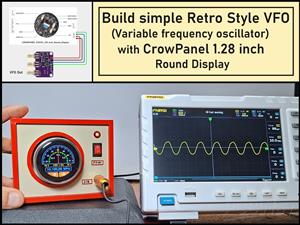 Build simple Retro Style VFO (Variable frequency oscillator) with Crowoanel 1.28 inch Round Display
Today I received a shipment with a Small round LCD display from Elecrow. The device is packed in tw...
Build simple Retro Style VFO (Variable frequency oscillator) with Crowoanel 1.28 inch Round Display
Today I received a shipment with a Small round LCD display from Elecrow. The device is packed in tw...
-
 Human vs Robot – Rock Paper Scissors with MyCobot 280 M5Stack
Today I received a package containing the few Elephant Robotics products. The shipment is well pack...
Human vs Robot – Rock Paper Scissors with MyCobot 280 M5Stack
Today I received a package containing the few Elephant Robotics products. The shipment is well pack...
-
 How to Build a Simple Audio Spectrum Analyzer with Adjustable Settings
An audio spectrum analyzer is an electronic device or software tool that measures and visually disp...
How to Build a Simple Audio Spectrum Analyzer with Adjustable Settings
An audio spectrum analyzer is an electronic device or software tool that measures and visually disp...
-
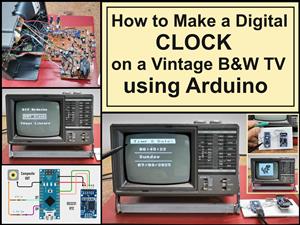 How to Make a Digital Clock on a Vintage B&W TV using Arduino
These days I accidentally came across this small retro Black and White TV with a built-in Radio, so ...
How to Make a Digital Clock on a Vintage B&W TV using Arduino
These days I accidentally came across this small retro Black and White TV with a built-in Radio, so ...
-
 Build a $10 Function Generator with Frequency Meter for Your Lab
A function generator is a piece of electronic test equipment used to generate various types of elec...
Build a $10 Function Generator with Frequency Meter for Your Lab
A function generator is a piece of electronic test equipment used to generate various types of elec...
-
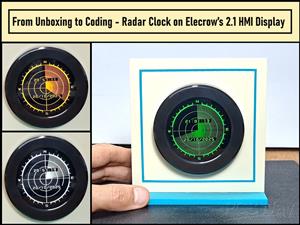 From Unboxing to Coding - Radar Clock on Elecrow’s 2.1 HMI Display
Today I received a shipment with a large round LCD display from Elecrow. The device is packed in two...
From Unboxing to Coding - Radar Clock on Elecrow’s 2.1 HMI Display
Today I received a shipment with a large round LCD display from Elecrow. The device is packed in two...
-
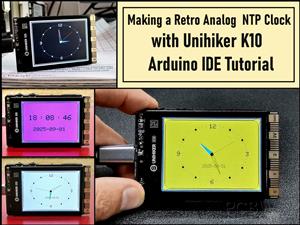 Making a Retro Analog NTP Clock with Unihiker K10 - Arduino IDE Tutorial
Some time ago I presented you a way to use standard Arduino libraries on the Unihiker k10 developme...
Making a Retro Analog NTP Clock with Unihiker K10 - Arduino IDE Tutorial
Some time ago I presented you a way to use standard Arduino libraries on the Unihiker k10 developme...
-
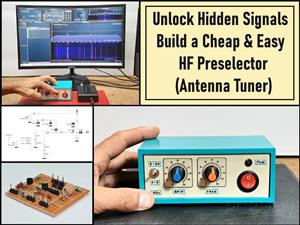 Build a Cheap & Easy HF Preselector - Antenna Tuner
HF antenna preselector is an electronic device connected between an HF radio antenna, and a radio r...
Build a Cheap & Easy HF Preselector - Antenna Tuner
HF antenna preselector is an electronic device connected between an HF radio antenna, and a radio r...
-
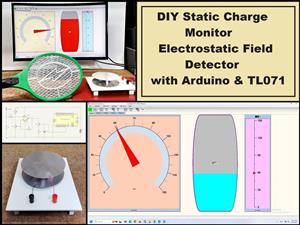 DIY Static Charge Monitor - Electrostatic Field Detector (Arduino & TL071)
A Static Charge Monitor also known as a Static Field Meter or Electrostatic Voltmeter is a device u...
DIY Static Charge Monitor - Electrostatic Field Detector (Arduino & TL071)
A Static Charge Monitor also known as a Static Field Meter or Electrostatic Voltmeter is a device u...
-
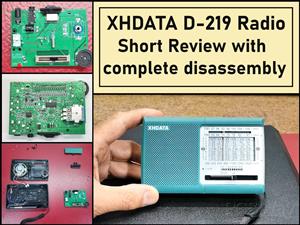 XHDATA D-219 Radio Short Review with complete disassembly
Some time ago I received an offer from XHDATA to be one of the first test users of their new radio m...
XHDATA D-219 Radio Short Review with complete disassembly
Some time ago I received an offer from XHDATA to be one of the first test users of their new radio m...
-
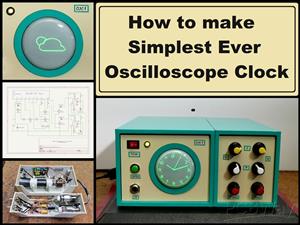 How to make Simplest ever Oscilloscope Clock
An oscilloscope clock is a unique and creative way to display the time using an oscilloscope, which...
How to make Simplest ever Oscilloscope Clock
An oscilloscope clock is a unique and creative way to display the time using an oscilloscope, which...
-
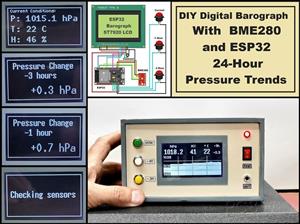 DIY Digital Barograph with BME280 and ESP32 - 24 Hour Pressure Trends
A barograph is a self-recording barometer that continuously measures and records atmospheric pressu...
DIY Digital Barograph with BME280 and ESP32 - 24 Hour Pressure Trends
A barograph is a self-recording barometer that continuously measures and records atmospheric pressu...
-
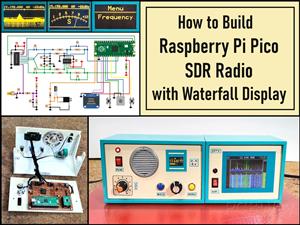 Build a Raspberry Pi Pico SDR Radio with Waterfall Display
Software-defined radio (SDR) is a radio communication system where components that have traditional...
Build a Raspberry Pi Pico SDR Radio with Waterfall Display
Software-defined radio (SDR) is a radio communication system where components that have traditional...
-
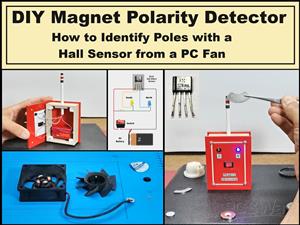 DIY Magnet Polarity Detector - How to Identify Poles with a Hall Sensor from a PC Fan
Recently, while working on a project, I needed to determine the polarity of several permanent magne...
DIY Magnet Polarity Detector - How to Identify Poles with a Hall Sensor from a PC Fan
Recently, while working on a project, I needed to determine the polarity of several permanent magne...
-
 Light Meter Project - Making Dfrobot Unihiker K10 Work with Standard Arduino Libraries
The other day I received a shipment with a UNIHIKER K10 development board from DFRobot, which I rec...
Light Meter Project - Making Dfrobot Unihiker K10 Work with Standard Arduino Libraries
The other day I received a shipment with a UNIHIKER K10 development board from DFRobot, which I rec...
-
-
AEL-2011 Power Supply Module
543 0 2 -
AEL-2011 50W Power Amplifier
505 0 2 -
-
-
Custom Mechanical Keyboard
706 0 0 -
Tester for Touch Screen Digitizer without using microcontroller
335 2 2 -
Audio reactive glow LED wristband/bracelet with NFC / RFID-Tags
317 0 1 -
-
-












































